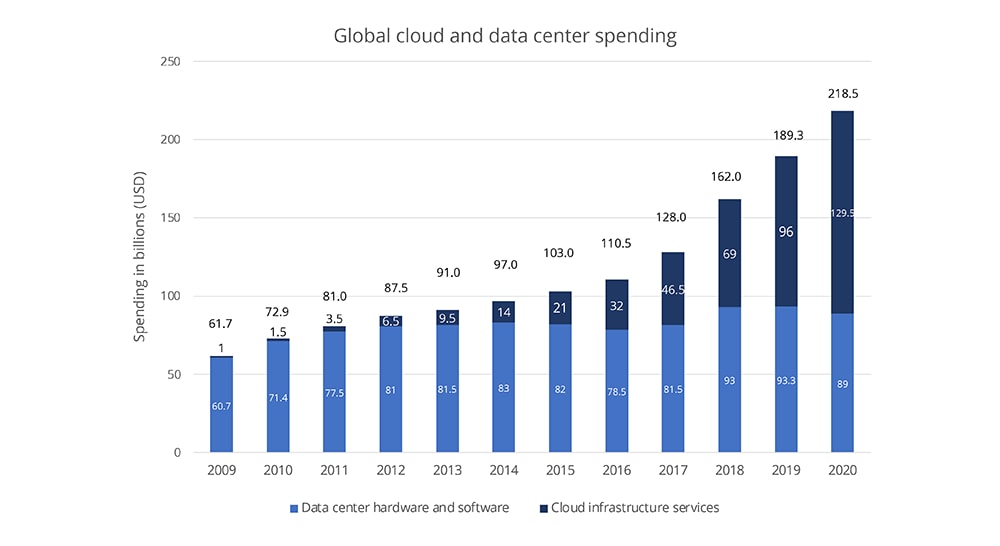Enabling the data center of the future has been saved

Perspectives
Enabling the data center of the future
The case for on-premise XaaS data centers
In a world where more and more companies are living in the cloud, rediscover the benefits of running on-premise data centers—and how an everything-as-a-service (XaaS) model can offer the flexibility and scalability to enable the data center of the future.
The cloud is here to stay
The accelerated and sustained growth of cloud services adoption has transformed the world of information technology (IT) over the past decade, repositioning enterprise IT—previously considered a pure support function—as a primary player in operations, new product development, and in-house innovation hubs. Indeed, the benefits that the cloud has helped catalyze across end users and small and medium enterprises are numerous, substantial, and undeniable.
IT, once a major upfront investment and a barrier to entry for small companies, is now available at any scale and is fully self-service. As a result, a small player can leverage cloud services to spend more time on mission-critical activities dedicated to growing the company without having to invest in additional talent and one-time capital expenditures for back-end operation assets. The cloud’s flexibility and scalability provide an ideal platform to quickly ideate, build, validate, and grow a product. In light of the benefits associated with the cloud, one could argue that starting in the cloud should be a baseline strategy for most companies.
Why run data centers on-premise?
The cloud’s flexibility and scalability may come at a cost premium, and a company operating at scale may find its costs of operating within the cloud to exceed that of maintaining an on-premise (on-prem) operation: Equivalent workloads running in the cloud under public prices are estimated to be 10–12 times more expensive than the cost of running on-premise data centers—even accounting for talent, hardware, and real estate costs.1 This observation should not come as a surprise since publicly listed cloud prices often do not incorporate negotiated discounting, especially in business-to-business (B2B) environments. As a result, a company’s cloud cost can still be more expensive than running on-premise data center operations in spite of discount pricing from committed capacity agreements.
The rationale for hosting workloads on-premise may extend beyond finances. In this paper, we explore additional circumstances where it makes sense to keep or move workloads on-premise. For these cases, we will discuss how to operationalize on-premise hosting to realize a competitive advantage, answering this question: Should all our workloads live in the cloud, or should we repatriate any workloads to our on-premise data center?
The answer is twofold:
- Strategically balance a multi-cloud strategy that intelligently identifies workloads, operations, and teams that are operating in the cloud, in a hybrid cloud/on-premise arrangement, or in on-premise data centers; and
- Use XaaS to enable the on-premise data center of the future.
Gartner projects that by 2025, 85% of infrastructure strategies will integrate on-premise, colocation, cloud, and edge delivery options, compared to 20% in 2020.2 The issue is not cloud versus an on-premise data center but rather balancing flexibility and realizing optimization at scale.
Amid cloud’s growth, is the on-premise data center going away?
Trends show that cloud providers may continue to gain market share in generalized storage and compute in coming years. In fact, both Statista and Synergy Research Group cited 2019 as the first year that cloud infrastructure services (CIS) spend surpassed traditional data center hardware and software spend (figures 1 and 2).3 However, CIS growth has not come at the expense of data center hardware and software spend, which has remained roughly constant at a compound annual growth rate of roughly 2.2% over the past 10 years.


Data supports the idea that enterprises are spending more on IT infrastructure services today than before, but will this trend continue? How will enterprises manage their on-premise data center operations in the years to come, and will there eventually be a decline in future data center spend?
We see hybrid cloud/on-premise and distributed cloud becoming the future of IT, and many organizations in the technology industry echo this hypothesis. According to Dell Technologies, “The inevitable result of this on-prem vs. cloud debate is that organizations frequently adopt multiple public cloud solutions and while also investing in private cloud infrastructure, creating a multi-cloud environment that is intended to meet all needs.”4 Similarly, Amazon Web Services (AWS) extended its reach in 2019 by offering products for infrastructure on-premise as part of its AWS Outposts product. AWS Outposts’ list of benefits cites enabling a consistent hybrid experience by running a host of AWS storage and compute services on-premise, recognizing use cases and industries that will remain on-premise in the future.5
The role of XaaS in the data center of the future
As organizations continue to move into the hybrid and distributed cloud world of IT, on-premise data centers will need the ability to respond quickly to changing needs to overcome the general view that on-premise operations tend to sacrifice flexibility for control. Companies should consider shifting to as-a-service business models to create more flexibility within the on-premise data center and address pain points experienced with traditional one-time hardware asset purchases. According to Deloitte’s 2021 edition of its Everything -as-a-Service (XaaS) Study, more than 50% of companies classified as leading adopters of as-a-service models reported improved decision-making, better collaboration, accelerated experimentation, and an ability to reinvent business processes as organizational benefits of adopting XaaS offers in their business operations.6
In an XaaS model for product-centric businesses, customers consume hardware assets and maintenance as a service, giving IT control and greater flexibility over what they consume and pay for. XaaS offerings for product-centric businesses typically bundle hardware with software and support services to give users optimal management of their assets and the ability to right-size their on-premise hardware asset inventory according to their needs at any point in the growth journey. This typically removes the need for bulk investments in hardware assets, instead enabling ongoing increment and asset mix adjustments according to business needs. In this way, the hardware asset provider builds a relationship driven by the customer’s success and growth.
XaaS can solve pain points that may arise when product-centric businesses run on-premise data centers under a traditional one-time purchase for hardware assets. Thus, XaaS has the potential to provide the following benefits:
- Asset flexibility—Customer may adjust on-premise hardware asset mix incrementally at any point in time.
- Scalability on demand—Customer may adjust capacity and pay only for the assets on-premise at any point in time.
- Purchasing experience—Customer pays for IT hardware assets and maintenance as a recurring operating expenses (OpEx).
- Ongoing support—Customer selects the desired level of support to help optimally manage assets.
We acknowledge that despite the added flexibility that comes with consuming hardware assets as a service, not all customers have the physical space, energy capacity, or cooling systems to adjust capacity on-premise. Our research found that hardware providers are responding by offering modular data center solutions designed to address customers with limited space, edge computing needs, and even modular cryptocurrency mining operations. These solutions revive concepts proved in the mid-2000s, allowing customers to purchase a “data center in a box,” a fully integrated, plug-and-play data center inside a shipping container designed to expand on-site data center operations. Other promising models include partnerships between colocation data center providers and server management software providers. Such market solutions further support the idea that there will continue to be an appetite for on-premise or colocated data center operations, particularly those that allow companies to rightsize IT and that demonstrate a real commitment for providers to grow with their customers.
It is important that the data center of tomorrow position itself as a scalable and flexible resource aligned with the hybrid cloud architecture of the future. By consuming hardware assets under an XaaS model, customers can position their on-premise data centers as internal, operationally optimized resources that deliver a consistent cloudlike experience. Dive deeper into the benefits—download the full report.
Get in touch
Contributors: Jorge Reyes, Malavika Sharma, Rohan Talukdar, and Julia Castanet
Endnotes
1 Sarah Wang and Martin Casado, “The cost of cloud, a trillion dollar paradox,” Andreessen Horowitz, May 27, 2021.
2 David Cappuccio and Roger Williams, “The everywhere enterprise: A Gartner Q&A with David Cappuccio,” Gartner, October 6, 2020.
3 Lionel Sujay Vailshery, “Global cloud and data center spending 2021,” May 15, 2023; Synergy Research Group, “2020 – The year that cloud service revenues finally dwarfed enterprise spending on data centers,” March 18, 2021.
4 Dell Technologies, “Hybrid cloud management,” accessed May 22, 2023.
5 Amazon Web Services, “AWS Outposts Family overview,” accessed May 22, 2023.
6 Susanne Hupfer et al., Gaining and sustaining a competitive edge with cloud and as-a-service IT, Deloitte Insights, 2021.
Recommendations
How enterprises can lead the way on cloud data security
As the demand for everything-as-a-service (XaaS) grows, it’s imperative that organizations focus on data security. Some security-savvy enterprises are already leading the way in choosing trustworthy XaaS vendors and establishing strong processes and policies to deal with data security.
Medtech services: Beyond the device
Everything-as-a-Service perspectives in health care






